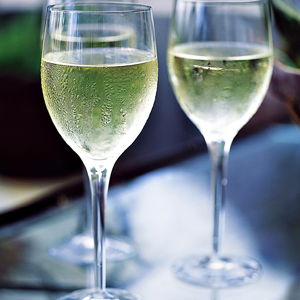SAUVIGNON BLANC
Origins and history: – comes from the north-west part of France and makes many of the famous white wines of the Loire Valley and, to a lesser extent, those of Bordeaux as well – probably its original home. Likes a cooler climate and needs careful handling as rather prone to oxidising (going brown like a sliced apple). Has had huge success in New Zealand and is becoming equally famous here in SA as well.
Characteristics: – distinctive grassy aromas and flavours, sometimes searing acidity. Fruit can range from green citrus and gooseberry to tropical guavas and litchis. Best examples are zingy and fresh with steely or nervy quality. Mostly unwooded (if it is wooded, it is called Blanc Fumé) and often blended with Semillon (rest of the world) or Chenin Blanc (South Africa).
Famous Wines: – Cloudy Bay (New Zealand), Sancerre, Pouilly-Fumé, Menetou-Salon (France)
Good Local Examples: – Steenberg, Diemersdal, Springfield, Cape Point, Iona
If it was a person: – Glenn Close
CHARDONNAY
Origins and history:– Most famous white grape of Burgundy and one of the most well-travelled grapes in the world. Easy to grow in a variety of climates and very versatile grape – these factors led to a huge amount of Chardonnay being grown in the 80’s and 90’s which in turn led to a subsequent backlash against the variety (ABC anything but chardonnay). Can be made in a variety of styles, wooded and unwooded and is also one of the main grapes of Champagne.
Characteristics: – ripe yellow fruit – melons, peaches, citrus – gaining honeyed complexity as it ages. Wooded versions can have butterscotch, baked peaches and toffee flavours whilst unwooded ones often surprise with their citrussy acidity and bite. Generally higher in alcohol than most white wines.
Famous Wines: – Puligny-Montrachet, Pouilly-Fuissé, Meursault, Chablis (all France)
Good Local Examples:- Ataraxia, Hamilton-Russell, Rustenburg, Jordan, Glen Carlou
If it was a person: – Aretha Franklin
CHENIN BLANC
Origins and history:- Originates in France in the Loire Valley and makes some of the most varied and long-lived wines in the world. Actually, South Africa has approximately three times as much Chenin as France, many of these vines very old and well-established. Also known here as ‘Steen’, Chenin is undergoing a serious image makeover from its reputation as cheap and cheerful unwooded wines to ones of complexity, depth, longevity and interest – if SA is going to make a world-beating wine, it will probably be from Chenin Blanc. Also makes some of the longest-lived sweet wines in the world.
Characteristics:- flavours of ripe apples and pears in youth, maturing to honeyed richness, ‘wet wool’, buttered toast all balanced by a high acidity. Can be unwooded, wooded, dry, semi-sweet or if conditions are right, fully sweet as a result of noble rot.
Famous wines:- Vouvray, Savennieres, Coteaux du Layon (all off-dry to sweet French wines)
Good Local examples:- Ken Forrester, Raats Family, Teddy Hall, Eben Sadie
If it was a person: – Scarlett Johannsson
SEMILLON
Origins and history:- Most important white grape in Bordeaux and capable of making a wide range of styles and tastes. Often blended with Sauvignon to great success and the Australians also frequently combine it with Chardonnay as well. Makes some of the world’s most expensive and long-lived sweet wines – Sauternes. Widely-planted all over the world, it used to be known as ‘groen’ grape in SA and considered unexciting, but with the interest in Sauvignon increasing, so plantings of Sémillon are on the up as well. The Australians have made a big thing of a distinctive, richly full-bodied style of Semillon in the Hunter Valley
Characteristics:– Strongly herbaceous aromas when young, tending to turn into beeswax and honey as it ages. When wooded, many people struggle to tell it apart from Chardonnay (honeyed yellow fruit and butterscotch) – best thing to look out for is the herbaceous, green edge which never really goes away.
Famous wines:- Château Yquem (Sauternes, France), De Bortoli (Australia)
Good Local examples:- Steenberg, Constantia Uitsig, Nitida, Boekenhoutskloof
If it was a person: – Angelina Jolie
VIOGNIER
Origins and history:- Top-quality white grape of the Rhône Valley, frequently added to top red wines as well to give them additional aromas and perfume. Grew in popularity in the 90’s and increasing plantings in SA, both for blending and for making as single varietals. Tends to get quite alcoholic as it ripens late and also very prone to diseases.
Characteristics:- very distinctive aromas of peaches and apricots – both fresh and tinned. Can also have floral notes and some spices – cloves, ginger and cinnamon. Both wooded and unwooded versions frequently available and, because of the distinctive character, Viognier is one of the easiest varieties to identify in blends.
Famous wines:- Château Grillet, Condrieu (both France)
Good Local examples:- Vrede en Lust, Fairview, Rusticus
If it was a person: – Catherine Zeta Jones
RIESLING
Origins and history:- The great grape of Germany, makes all their best wines. Also widely grown in the Alsace region of France. Gets confused in SA with an inferior grape variety known as Cape Riesling or Paarl Riesling which is in fact Crouchen Blanc. Proper, quality Riesling in SA is labelled Weisser Riesling or Rhine Riesling and is completely different to Cape Riesling. Likes very extreme and cool climates and vineyard selection is crucial. Makes a wide range of styles from bone dry to some of the most luscious and delicious sweet wines in the world.
Characteristics:- when young, has floral aromas and flavours and bags of acidity, but as it ages, it takes on distinctive kerosene or petrol overtones which sounds awful, but can be delicious. Sweet versions often have a strong, herbal, honey tweak to them.
Famous wines:- Liebfraumilch, Dr Loosen, Maximin Grünhaus, (all German), Hugel, Trimbach (both Alsace)
Good local examples:- Paul Cluver, Hartenberg, Thelema, Klein Constantia
If it was a person: – Keira Knightley

